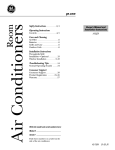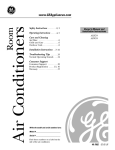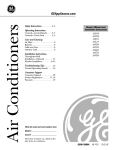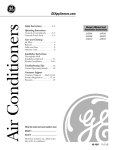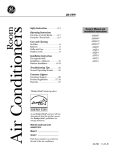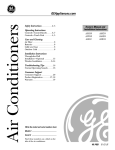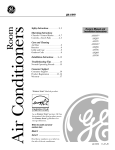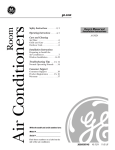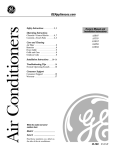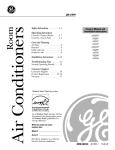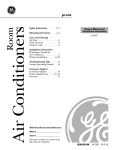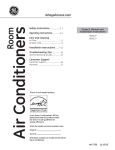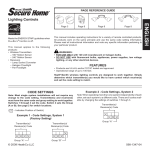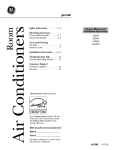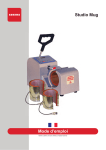Download Window Installation Instructions
Transcript
Room Air Conditioners ge.com Safety Instructions . . . . . . . . . .2, 3 Operating Instructions Owner’s Manual and Installation Instructions Controls—Control Knobs . . . . .6, 7 Controls—Touch Pads . . . . . . .4, 5 ASM14* ASH18 ASM18* ASQ18 ASV18 ASW18 ASM24* Care and Cleaning Air Filter . . . . . . . . . . . . . . . . . . . . .8 Batteries . . . . . . . . . . . . . . . . . . . . .8 Grille and Case . . . . . . . . . . . . . . .8 Outdoor Coils . . . . . . . . . . . . . . . .8 Installation Instructions Through-the-Wall Installation—Optional . . . . . . . .15 Window Installation . . . . . . . . .9–14 Troubleshooting Tips . . . . . . . .16 Normal Operating Sounds . . . . .16 Consumer Support Consumer Support . . . . . . . . . . .20 Product Registration . . . . . . .17, 18 Warranty . . . . . . . . . . . . . . . . . . . .19 *ENERGY STAR® labeled product As an ENERGY STAR® partner, GE has determined that this product meets the ENERGY STAR® guidelines for energy efficiency. Write the model and serial numbers here: Model # __________________________ Serial # __________________________ Find these numbers on a label on the side of the air conditioner. DB98-26676A 49-7555 10-06 JR WARNING! For your safety, the information in this manual must be followed to minimize the risk of fire, electric shock or personal injury. SAFETY PRECAUTIONS ■ Use this appliance only for its intended purpose as described in this Owner’s Manual. Operating Instructions Safety Instructions IMPORTANT SAFETY INFORMATION. READ ALL INSTRUCTIONS BEFORE USING. ■ This air conditioner must be properly installed in accordance with the Installation Instructions before it is used. ■ Never unplug your air conditioner by pulling on the power cord. Always grip plug firmly and pull straight out from the receptacle. Installation Instructions ■ Replace immediately all electric service cords that have become frayed or otherwise damaged. A damaged power supply cord must be replaced with a new power supply cord obtained from the manufacturer and not repaired. Do not use a cord that shows cracks or abrasion damage along its length or at either the plug or connector end. ■ Turn the unit OFF and unplug your air conditioner before making any repairs or cleaning. NOTE: We strongly recommend that any servicing be performed by a qualified individual. ■ For your safety…do not store or use combustible materials, gasoline or other flammable vapors or liquids in the vicinity of this or any other appliance. ■ All air conditioners contain refrigerants, which under federal law must be removed prior to product disposal. If you are getting rid of an old product with refrigerants, check with the company handling disposal about what to do. Troubleshooting Tips HOW TO CONNECT ELECTRICITY Do not, under any circumstances, cut or remove the third (ground) prong from the power cord. For personal safety, this appliance must be properly grounded. Where a 2-prong wall outlet is encountered, it is your personal responsibility and obligation to have it replaced with a properly grounded 3-prong wall outlet. The power cord of this appliance is equipped with a 3-prong (grounding) plug which mates with a standard 3-prong (grounding) wall outlet to minimize the possibility of electric shock hazard from this appliance. The air conditioner should always be plugged into its own individual electrical outlet which has a voltage rating that matches the rating plate. Consumer Support Power cord includes a current interrupter device. A test and reset button is provided on the plug case. The device should be tested on a periodic basis by first pressing the TEST button and then the RESET button. If the TEST button does not trip or if the RESET button will not stay engaged, discontinue use of the air conditioner and contact a qualified service technician. Have the wall outlet and circuit checked by a qualified electrician to make sure the outlet is properly grounded. 2 This provides the best performance and also prevents overloading house wiring circuits which could cause a fire hazard from overheated wires. See the Installation Instructions, Electrical Requirements section for specific electrical connection requirements. WARNING! USE OF EXTENSION CORDS—115-Volt models only Because of potential safety hazards under certain CAUTION: conditions, we strongly recommend against the use of an extension cord. USE OF ADAPTER PLUGS—115-Volt models only However, if you must use an adapter, where local codes permit, a temporary connection may be made to a properly grounded 2-prong wall outlet by use of a UL-listed adapter available at most local hardware stores. The larger slot in the adapter must be aligned with the larger slot in the wall outlet to provide proper polarity in the connection of the power cord. When disconnecting the power cord from the adapter, always hold the adapter in place with one hand while pulling the power cord plug with the other hand. If this is not done, the adapter ground terminal is very likely to break with repeated use. If the adapter ground terminal breaks, DO NOT USE the air conditioner until a proper ground has been established. READ AND FOLLOW THIS SAFETY INFORMATION CAREFULLY. SAVE THESE INSTRUCTIONS Troubleshooting Tips Attaching the adapter ground terminal to a wall outlet cover screw does not ground the appliance unless the cover screw is metal, and not insulated, and the wall outlet is grounded through the house wiring. You should have the circuit checked by a qualified electrician to make sure the outlet is properly grounded. Installation Instructions Because of potential safety hazards under certain conditions, we strongly recommend against the use of an adapter plug. Operating Instructions However, if you must use an extension cord, it is absolutely necessary that it be a UL-listed, 14 gauge, 3-wire grounding type appliance extension cord having a grounding type plug and outlet and that the electrical rating of the cord be 15 amperes (minimum) and 125 volts. DO NOT use an extension cord with any of the 230/208 volt models. Safety Instructions ge.com Consumer Support 3 Safety Instructions About the controls on the air conditioner—models with touch pads. Features and appearance will vary. FAN On COOL On ENERGY SAVER On TIMER On Operating Instructions SLEEP On Air Conditioner Controls On/Off Timer Turns air conditioner on and off. On—When the air conditioner is off, it can be set to automatically turn on in 1 to 24 hours at its previous setting. Each touch will set the time in hours. Display Installation Instructions Displays the set temperature or time remaining on timer. Mode Use to set the air conditioner to Cool or Fan mode. Increase ▲ /Decrease ▼ Pads Use to set temperature when in Cool mode. Fan Use to set the fan speed at Low, Med or High. Circulaire (on some models) Troubleshooting Tips Remote Control Off—When the air conditioner is on, it can be set to automatically turn off in 1 to 24 hours. Each touch will set the time in hours. To cancel the timer, press the Timer pad until the display time disappears. Sleep (on some models) Press to set the air conditioner to run for 8 hours before it automatically shuts off. Turn on to provide continuous side-to-side air circulation. One hour after the sleep timer is set, the set temperature will automatically increase 2°F. For fixed side-to-side air direction, turn On until the desired air direction is obtained, then turn it Off. To cancel the sleep mode, press the Sleep pad a second time. Energy Saver– Controls the fan. On—The fan and compressor cycle on and off. This results in wider variations of room temperature and humidity. Normally used when the room is unoccupied. Note: The fan will continue to run for a short time after the compressor cycles off. Note: The sleep timer will be cancelled if the Timer, Energy Saver or Mode pad is pressed. Remote Control Signal Receiver Consumer Support Off—The fan runs all the time, while the compressor cycles on and off. This switch must be set at Off in order to use the fan settings (on the mode control). Remote Control 4 ■ To ensure proper operation, aim the remote control at the signal receiver on the air conditioner. ■ Make sure nothing is between the air conditioner and the remote control that could block the signal. ■ The remote control signal has a range of up to 21 feet. ■ Make sure batteries are fresh and installed correctly—see the Care and Cleaning section. Additional controls and important information. Do Not Operate in Freezing Outdoor Conditions This cool-only air conditioner was not designed for freezing outdoor conditions. It must not be used in freezing outdoor conditions. Safety Instructions ge.com When the air conditioner is turned on, it will automatically start in the setting last used. Operating Instructions Power Outage Recovery Feature In the case of a power outage or interruption, the unit will automatically re-start in the settings last used after the power is restored. The Timer and Sleep features will reset to the original setting. You may need to set a new time if desired. Cool Mode Use the Cool mode with High (3), Med (2) or Low (1) fan for cooling. Use the Increase ▲ / Decrease ▼ pads to set the desired temperature between 64°F and 86°F in 1°F increments. NOTE: If the air conditioner is off and is then turned on while set to Cool, it will take approximately 3 minutes for the compressor to start and cooling to begin. For Normal Cooling—Select the Cool mode and High (3) or Med (2) fan with a middle set temperature. For Maximum Cooling—Select the Cool mode and High (3) fan with a lower set temperature. Installation Instructions A thermostat is used to maintain the room temperature. The compressor will cycle on and off to keep the room at the set level of comfort. Set the thermostat at a lower number and the indoor air will become cooler. Set the thermostat at a higher number and the indoor air will become warmer. Cooling Descriptions For Quieter & Nighttime Cooling—Select the Cool mode and Low (1) fan with a middle set temperature. NOTE: If you switch from a Cool setting to Off or to a fan setting, wait at least 3 minutes before switching back to a Cool setting. Fan Mode Use the Fan at High (3), Med (2) or Low (1) to provide air circulation and filtering without cooling. Since fan only settings do not provide cooling, a temperature setting will not be displayed. The vent control is located on the inside of the air louvers in the lower right corner. When set at CLOSE, only the air inside the room will be circulated and conditioned. When set at OPEN, some inside air is exhausted outside. OR To open the vent, push the lever to the right. To close it, push it to the left. To open the vent, push the lever to the right. To close it, push it to the left. Troubleshooting Tips Vent Control (on some models) Air Direction—Up and Down (on some models) Consumer Support Fingertip pressure on the horizontal louvers adjusts the air direction up or down. OR Air Direction—Side-to-Side (on some models) On some models, the side-to-side air direction is adjusted by the louver levers or by grasping and moving the inner vertical louvers. OR 5 Features and appearance may vary. Controls (on models so equipped) Operating Instructions Safety Instructions About the controls on the air conditioner—models with control knob(s). ON/OFF Switch Turns air conditioner on and off. NOTE: If the air conditioner is off and is then turned on while set in a Cool mode, it will take approximately 3 minutes for the compressor to start and cooling to begin. Installation Instructions Fan Switch (on some models) Use to set the fan speed to LO or HI. Mode/Temp Control Use to set the air conditioner to the Fan Only or a Cool mode. Fan Only Mode Use Fan Only at HI or LO Fan to provide air circulation and filtering without cooling. Troubleshooting Tips Cool Mode Use a Cool setting with HI or LO Fan for cooling. Turn the knob clockwise, toward the larger blue area, for the indoor area to become cooler. Turn the knob counterclockwise, toward the smaller blue area, for the indoor air to become warmer. The Mode/Temp control is used to maintain the room temperature. When set in a Cool mode, the compressor will cycle on and off to keep the room at the same level of comfort. Cooling Descriptions For Normal Cooling—Select a Cool mode with the Mode/Temp knob set at the midpoint. For Maximum Cooling—Select a Cool mode with the Mode/Temp knob set toward the larger blue area. For Quieter & Nighttime Cooling—Select a Cool mode with the Mode/Temp knob set toward the smaller blue area. NOTE: If you move the Mode/Temp control knob from a Cool setting to the Fan Only setting, wait at least 3 minutes before switching back to a Cool setting. Controls (on models so equipped) Mode Control Consumer Support Hi Cool, Med Cool and Low Cool provide cooling with different fan speeds. Low Fan or Hi Fan provides air circulation and filtering without cooling. Thermostat Control 6 The thermostat control is used to maintain the room temperature. The compressor will cycle on and off to keep the room at the same level of comfort. When you turn the knob to a higher number, the indoor air will become cooler. Turn the knob to a lower number and the indoor air will become warmer. NOTE: If you move the switch from a cool setting to OFF or to a fan setting, wait at least 3 minutes before switching back to a cool setting. Cooling Descriptions For Normal Cooling–Select Hi Cool or Med Cool with the thermostat control at midpoint. For Maximum Cooling–Select Hi Cool with the thermostat control at the highest number available on your knob. For Quieter & Nighttime Cooling–Select Low Cool with the thermostat control at midpoint. Additional controls and important information. Do Not Operate in Freezing Outdoor Conditions This cool-only air conditioner was not designed for freezing outdoor conditions. It must not be used in freezing outdoor conditions. Safety Instructions ge.com Vent Control (on some models) OR When set at CLOSE, only the air inside the room will be circulated and conditioned. When set at OPEN, some inside air is exhausted outside. To open the vent, push the lever to the right. To close it, push it to the left. To open the vent, push the lever to the right. To close it, push it to the left. Air Direction—Side-to-Side Installation Instructions On some models, the side-to-side air direction is adjusted by the louver levers or by grasping and moving the inner vertical louvers. Operating Instructions The vent control is located on the inside of the air louvers in the lower right corner. OR Air Direction—Up and Down (on some models) Troubleshooting Tips Fingertip pressure on the horizontal louvers adjusts the air direction up or down. OR Consumer Support 7 How to Insert the Batteries Operating Instructions Safety Instructions Care and cleaning of the air conditioner. 1 Remove the battery cover by sliding it according to the arrow direction. 2 Insert new batteries, making sure that the (+) and (–) of battery are installed correctly. 3 Reattach the cover by sliding it back into position. NOTES: ■ Use 2 AAA (1.5 volt) batteries. Do not use rechargeable batteries. ■ Remove the batteries from the remote control if the system is not going to be used for a long time. Grille and Case Turn the air conditioner off and remove the plug from the wall outlet before cleaning. To clean, use water and a mild detergent. Do not use bleach or abrasives. Outdoor Coils Installation Instructions The coils on the outdoor side of the air conditioner should be checked regularly. If they are clogged with dirt or soot, they may be professionally cleaned. Air Filter The air filter behind the front grille should be checked and cleaned at least every 30 days or more often if necessary. Clean the filter with warm, soapy water. Rinse and let the filter dry before replacing it. CAUTION: Troubleshooting Tips DO NOT operate the air conditioner without a filter because dirt and lint will clog it and reduce performance. Consumer Support To remove (on some models): 8 1 Open the inlet grille upward by pulling out the bottom of the inlet grille. 2 Using the tab, pull up slightly on the filter to release it and pull it down. To remove (on some models): Grab the tabs on the filter and pull it up and out. Installation Instructions Air Conditioner Questions? Call 800.GE.CARES (800.432.2737) or Visit our Website at: ge.com BEFORE YOU BEGIN CAUTION: Read these instructions completely and carefully. • IMPORTANT • IMPORTANT • • • • • • • • Do not, under any circumstances, cut or remove the third (ground) prong from the power cord. Do not change the plug on the power cord of this air conditioner. Aluminum house wiring may present special problems—consult a qualified electrician. — Save these instructions for local inspector’s use. — Observe all governing codes and ordinances. Note to Installer – Be sure to leave these instructions with the Consumer. Note to Consumer – Keep these instructions for future reference. Skill level – Installation of this appliance requires basic mechanical skills. Completion time – Approximately 1 hour We recommend that two people install this product. Proper installation is the responsibility of the installer. Product failure due to improper installation is not covered under the Warranty. You MUST use all supplied parts and use proper installation procedures as described in these instructions when installing this air conditioner. TOOLS YOU WILL NEED Phillips head screwdriver Pencil Ruler or tape measure Level Scissors or knife ELECTRICAL REQUIREMENTS Some models require a 115/120-volt a.c., 60 Hz grounded outlet protected with a 15-amp time delay fuse or circuit breaker. The 3-prong grounding plug minimizes the possibility of electric shock hazard. If the wall outlet you plan to use is only a 2-prong outlet, it is your responsibility to have it replaced with a properly grounded 3-prong wall outlet. Adjustable wrench Power cord includes a current interrupter device. A test and reset button is provided on the plug case. The device should be tested on a periodic basis by first pressing the TEST button and then the RESET button. If the TEST button does not trip or if the RESET button will not stay engaged, discontinue use of the air conditioner and contact a qualified service technician. Some models require 230/208-volt a.c., protected with a time delay fuse or circuit breaker. These models should be installed on their own single branch circuit for best performance and to prevent overloading house or apartment wiring circuits, which could cause a possible fire hazard from overheating wires. 9 Window Installation Instructions PARTS INCLUDED (appearance may vary) Window sash seal Left accordion panel Foam top window gasket Top mounting rail Top mounting rail seal strip Right accordion panel Bottom inner case gasket Sill support (2) Type A (21) 1/2″ screws Type B (10) 3/4″ screws Type C bolt (2) 10 Security bracket (1) Window Installation Instructions 1 WINDOW REQUIREMENTS 3 REMOVE THE FRONT GRILLE (IF ATTACHED) • These instructions are for a standard double-hung window. You will need to modify them for other types of windows. • All supporting parts must be secured to firm wood, masonry or metal. • The electrical outlet must be within reach of the power cord. A Remove shipping tape, if present. On models with a raise-up inlet grille, lift it and remove the screw behind it (if present) that holds the grille in place. On models with a slide-out air filter, remove it and the screw behind it (if present) that holds the grille in place. B Gently but firmly grasp the lower grille corners, press in on the case sides and pull forward to release. NOTE: Do not pull the bottom edge toward you more than 3″ or you may damage the tabs of the grille. C Lift the grille up and off the top tabs. 173⁄8″ min. 281⁄2″ to 39″ (With accordion panels) 2 STORM WINDOW REQUIREMENTS A storm window frame will not allow the air conditioner to tilt toward the outside, and will keep it from draining properly. To adjust for this, attach a piece of wood to the stool. WOOD PIECES– WIDTH: 2″ LENGTH: Long enough to fit inside the window frame. THICKNESS: To determine the thickness, place a piece of wood on the stool to make it 1/2″ higher than the top of the storm window frame or the vinyl frame. Attach securely with nails or screws provided by the installer. 1/2″ higher than vinyl frame (on some windows) 1/2″ higher than storm window frame Storm window frame Wood Stool Vinyl frame 11 Window Installation Instructions 5 PREPARE THE CASE 4 REMOVE THE AIR CONDITIONER FROM THE CASE A Remove the backing from the top mounting rail seal strip and attach it to the bottom of the top mounting rail. Cut to size. A Remove the 4 screws on each side of the case. Keep the 2 front-side screws for later use. B Install the top mounting rail with 5 type A screws from the outside of the case. Front of air conditioner Top mounting rail B Slide the air conditioner from the case by gripping the base pan handle and pulling forward while bracing the case. Bottom mounting rail C Insert the frames for the accordion panels into the top and bottom mounting rails. Attach the accordion panels to the side of the case using 8 type A screws. Front of air conditioner Remove packing cardboard and tape, if present. Top mounting rail Accordion panel Type A screws BACK Bottom mounting rail 12 Window Installation Instructions 6 INSTALL THE CASE 7 INSTALL THE SECURITY IN THE WINDOW BRACKET AND THE FOAM TOP WINDOW GASKET A Cut the window sash seal to the window width and stick the adhesive side to the bottom of the sash. A Attach the security bracket with a type B screw. Window sash seal B Thread two type C bolts into the support brackets. B Cut the foam top window gasket to the window width. Slide the case into the window and lower the window behind the top mounting rail. C Stuff the foam between the glass and the window to prevent air and insects from getting into the room. Position the brackets on the case bottom so they will be near the outermost point on the window sill. Attach the support brackets to each side of the case bottom using 4 type A screws on each side. The case should be slightly tilted to the outside. Use a level; about a 1/2 bubble will be the correct case slant to the outside. Adjust the leveling bolts to touch the sill. Type A screws Type C bolts C Locate the 8 screw holes along the bottom front edge of the case. Center the case, sideto-side, in the window and mount it to the window sill using 5 type B screws staggered in the front and back rows if possible. Top mounting rail Type B screws Type B screws Type B screws D Extend the left and right accordion panels to the vertical window sashes and attach with 4 type B screws. 13 Window Installation Instructions 8 INSTALL THE AIR CONDITIONER IN THE CASE A Slide the air conditioner into the case. Reinstall the 2 front-side screws removed earlier on each side of the case. B Place the bottom inner case gasket between the bottom of the air conditioner and the inside bottom of the case. Fold up the ends on both sides and push them in. Front of air conditioner Bottom inner case gasket C Attach the front grille to the case by inserting the tabs on the grille into the slots on the front of the case. Push the grille in until it snaps into place. Guide the lever carefully through the grille as you push it in. D Secure the front grille to the case by replacing the screw removed in Step 3. Caulk or weather-strip any gaps or openings to the outside to seal the installation. The installation is now complete. 14 Through-the-Wall Installation Instructions—Optional 1 IMPORTANT (cont.) The case may be installed through-the-wall in both existing and new construction. Read completely, then follow step-by-step. NOTE: Obtain all materials locally for mounting the air conditioner throughthe-wall. D Secure with 14 wood screws anchored at least an inch into the wall support structure. NOTE: Drill pilot holes, if necessary, for proper installation. If the frame is oversized, use shims to prevent case distortion. 1 IMPORTANT 2 FINISH THE WALL OPENING Through-the-wall installation is not appropriate if any of the side or top louvers in the case will be obstructed by the wall. A Caulk all four sides on the outdoor side of the case to prevent moisture from getting through to the interior wall. Use of flashing (drip rail) will further prevent water from dripping inside the wall and down the outside of the building. All side and top louvers in the case must project on the outdoor side of the wall. The room side of the case must project into the room far enough to maximize the balance of the unit. Plaster line The case must be installed level from sideto-side and with a slight tilt from front to rear. Use a level; no more than a 1/2 bubble will be the correct case slant to the outside. Lintel angle Trim molding (if desired) Caulking Lintel angle is required to support bricks or blocks above opening. OUTSIDE INSIDE Flashing is required and should extend the length of the opening to ensure no inside cavity leakage occurs. Air louvers (top and sides must project on the outdoor side of the wall) A Remove the air conditioner from the case. For specific instruction, refer to the Window Installation Instructions. B Make certain that a wall receptacle is available close to the hole location or make arrangements to install a receptacle. Bottom rail Wood filler and caulking (above and below the flashing) Flashing (Drip rail) Flashing (Drip rail) C Place the case in the wall opening and place wood support strips between the case bottom and the flashing on both sides of the bottom rail. They should be the same height as the bottom rail and the same length as the wall opening. Case bottom Bottom rail Wood support strips B Place the air conditioner into the case. For specific instruction, refer to the Window Installation Instructions. 15 Safety Instructions Operating Instructions Installation Instructions Problem Possible Causes What To Do Air conditioner does not start The air conditioner is unplugged. • Make sure the air conditioner plug is pushed completely into the outlet. The fuse is blown/circuit breaker is tripped. • Check the house fuse/circuit breaker box and replace the fuse or reset the breaker. Power failure. • If power failure occurs, turn the air conditioner Off. When power is restored, wait 3 minutes to restart the air conditioner to prevent tripping of the compressor overload. The current interrupter device is tripped. • Press the Reset button located on the power cord plug. • If the Reset button will not stay engaged, discontinue use of the air conditioner and contact a qualified service technician. Airflow is restricted. • Make sure there are no curtains, blinds or furniture blocking the front of the air conditioner. The temp control may not be set correctly. • On models with touch pads: In Cool mode, press the Decrease ▼ pad. • On models with control knobs, turn the temperature knob to a higher number. The air filter is dirty. • Clean the filter at least every 30 days. See the Operating Instructions section. The room may have been hot. • When the air conditioner is first turned on, you need to allow time for the room to cool down. Cold air is escaping. • Check for open furnace registers and cold air returns. • Set the air conditioner’s vent to the closed position. Cooling coils have iced up. • See “Air conditioner freezing up” below. Air conditioner freezing up Ice blocks the air flow and stops the air conditioner from cooling the room. • On models with control knobs, set the mode control at High Fan or High Cool with the temp at 1 or 2. • On models with touch pads, set the controls at High Fan or High Cool and set the thermostat to a higher temperature. The remote control is not working The batteries are inserted incorrectly. • Check the position of the batteries. They should be inserted in the opposite (+) and (–) direction. The batteries may be dead. • Replace the batteries. Water drips outside Hot, humid weather. • This is normal. Water drips indoors The air conditioner is not tilted to the outside. • For proper water disposal, make sure the air conditioner slants slightly from the case front to the rear. Water collects in base pan Moisture removed from air and drains into base pan. • This is normal for a short period in areas with little humidity; normal for a longer period in very humid areas. “E1” appears in the display Function error code. • Unplug the air conditioner. Wait 3 minutes and plug it back in. Timer or Sleep feature not working properly A power outage or interruption occurred. • In the case of a power outage or interruption, the unit Timer and Sleep features will reset to the original setting. You may need to set a new time if desired. Air conditioner does not cool as it should Consumer Support Troubleshooting Tips Troubleshooting Tips… Normal Operating Sounds ■ You may hear a pinging noise caused by water being picked up and thrown against the condenser on rainy days or when the humidity is high. This design feature helps remove moisture and improve efficiency. 16 ■ You may hear the thermostat click when the compressor cycles on and off. ■ Water will collect in the base pan during high humidity or on rainy days. The water may overflow and drip from the outdoor side of the unit. ■ The fan may run even when the compressor does not. GE Service Protection Plus™ GE, a name recognized worldwide for quality and dependability, offers you Service Protection Plus ™—comprehensive protection on all your appliances— No Matter What Brand! Benefits Include: • Backed by GE • All brands covered • Unlimited service calls • All parts and labor costs included • No out-of-pocket expenses • No hidden deductibles • One 800 number to call We’ll Cover Any Appliance. Anywhere. Anytime.* You will be completely satisfied with our service protection or you may request your money back on the remaining value of your contract. No questions asked. It’s that simple. Protect your refrigerator, dishwasher, washer and dryer, range, TV, VCR and much more—any brand! Plus there’s no extra charge for emergency service and low monthly financing is available. Even icemaker coverage and food spoilage protection is offered. You can rest easy, knowing that all your valuable household products are protected against expensive repairs. Place your confidence in GE and call us in the U.S. toll-free at 800.626.2224 for more information. *All brands covered, up to 20 years old, in the continental U.S. ✁ Cut here Please place in envelope and mail to: General Electric Company Warranty Registration Department P.O. Box 32150 Louisville, KY 40232-2150 17 Consumer Product Ownership Registration Dear Customer: Thank you for purchasing our product and thank you for placing your confidence in us. We are proud to have you as a customer! Follow these three steps to protect your new appliance investment: 1 2 3 Complete and mail your Consumer Product Ownership Registration today. Have the peace of mind of knowing we can contact you in the unlikely event of a safety modification. After mailing the registration below, store this document in a safe place. It contains information you will need should you require service. Our service number is 800.GE.CARES (800.432.2737). Model Number Read your Owner’s Manual carefully. It will help you operate your new appliance properly. Serial Number Important: If you did not get a registration card with your product, detach and return the form below to ensure that your product is registered, or register online at ge.com. ✁ Cut here Consumer Product Ownership Registration Model Number ant ort l p Im Mai ay! d To Mr. ■ Ms. ■ Mrs. ■ Serial Number Miss ■ First Name Last Name Street Address Apt. # E-mail Address* Date Placed In Use Month Zip Code State City Day GE Consumer & Industrial Appliances General Electric Company Louisville, KY 40225 ge.com Year Phone Number _ _ * Please provide your e-mail address to receive, via e-mail, discounts, special offers and other important communications from GE Appliances (GEA). ■ Check here if you do not want to receive communications from GEA’s carefully selected partners. FAILURE TO COMPLETE AND RETURN THIS CARD DOES NOT DIMINISH YOUR WARRANTY RIGHTS. For information about GEA’s privacy and data usage policy, go to ge.com and click on “Privacy Policy” or call 800.626.2224. 18 All warranty service provided by our Factory Service Centers, or an authorized Customer Care® technician. To schedule service, on-line, 24 hours a day, visit us at ge.com, or call 800.GE.CARES (800.432.2737). Please have serial number and model number available when calling for service. Staple your receipt here. Proof of the original purchase date is needed to obtain service under the warranty. GE Will Replace: One Year From the date of the original purchase Any part of the air conditioner which fails due to a defect in materials or workmanship. During this limited one-year warranty, GE will also provide, free of charge, all labor and related service to replace the defective part. Five Years From the date of the original purchase Any part of the sealed refrigerating system (the compressor, condenser, evaporator and all connecting tubing) which fails due to a defect in materials or workmanship. During this four-year limited additional warranty, GE will also provide, free of charge, all labor and related service to replace the defective part. Operating Instructions For The Period Of: What Is Not Covered: ■ Replacement of house fuses or resetting of circuit breakers. ■ Improper installation, delivery or maintenance. If you have an installation problem, or if the air conditioner is of improper cooling capacity for the intended use, contact your dealer or installer. You are responsible for providing adequate electrical connecting facilities. ■ Failure due to corrosion on models not corrosionprotected. ■ Failure of the product resulting from modifications to the product or due to unreasonable use including failure to provide reasonable and necessary maintenance. ■ Incidental or consequential damage caused by possible defects with this air conditioner. ■ Damage caused after delivery. ■ Product not accessible to provide required service. EXCLUSION OF IMPLIED WARRANTIES—Your sole and exclusive remedy is product repair as provided in this Limited Warranty. Any implied warranties, including the implied warranties of merchantability or fitness for a particular purpose, are limited to one year or the shortest period allowed by law. This warranty is extended to the original purchaser and any succeeding owner for products purchased for home use within the USA. If the product is located in an area where service by a GE Authorized Servicer is not available, you may be responsible for a trip charge or you may be required to bring the product to an Authorized GE Service location for service. In Alaska, the warranty excludes the cost of shipping or service calls to your home. Warrantor: General Electric Company. Louisville, KY 40225 19 Consumer Support Some states do not allow the exclusion or limitation of incidental or consequential damages. This warranty gives you specific legal rights, and you may also have other rights which vary from state to state. To know what your legal rights are, consult your local or state consumer affairs office or your state’s Attorney General. Troubleshooting Tips ■ In commercial locations labor necessary to move the unit to a location where it is accessible for service by an individual technician. ■ Damage to the product caused by improper power supply voltage, accident, fire, floods or acts of God. Installation Instructions ■ Service trips to your home to teach you how to use the product. Safety Instructions GE Air Conditioner Warranty. Consumer Support. GE Appliances Website ge.com Have a question or need assistance with your appliance? Try the GE Appliances Website 24 hours a day, any day of the year! For greater convenience and faster service, you can now download Owner’s Manuals, order parts or even schedule service on-line. Schedule Service ge.com Expert GE repair service is only one step away from your door. Get on-line and schedule your service at your convenience 24 hours any day of the year! Or call 800.GE.CARES (800.432.2737) during normal business hours. Real Life Design Studio ge.com GE supports the Universal Design concept—products, services and environments that can be used by people of all ages, sizes and capabilities. We recognize the need to design for a wide range of physical and mental abilities and impairments. For details of GE’s Universal Design applications, including kitchen design ideas for people with disabilities, check out our Website today. For the hearing impaired, please call 800.TDD.GEAC (800.833.4322). Extended Warranties ge.com Purchase a GE extended warranty and learn about special discounts that are available while your warranty is still in effect. You can purchase it on-line anytime, or call 800.626.2224 during normal business hours. GE Consumer Home Services will still be there after your warranty expires. Parts and Accessories ge.com Individuals qualified to service their own appliances can have parts or accessories sent directly to their homes (VISA, MasterCard and Discover cards are accepted). Order on-line today, 24 hours every day or by phone at 800.626.2002 during normal business hours. Instructions contained in this manual cover procedures to be performed by any user. Other servicing generally should be referred to qualified service personnel. Caution must be exercised, since improper servicing may cause unsafe operation. Contact Us ge.com If you are not satisfied with the service you receive from GE, contact us on our Website with all the details including your phone number, or write to: General Manager, Customer Relations GE Appliances, Appliance Park Louisville, KY 40225 Register Your Appliance ge.com Register your new appliance on-line—at your convenience! Timely product registration will allow for enhanced communication and prompt service under the terms of your warranty, should the need arise. You may also mail in the pre-printed registration card included in the packing material. 20 Printed in China Acondicionadores de Aire ge.com Instrucciones de seguridad . . . . .2, 3 Instrucciones de operación Manual del Propietario e Instrucciones de Instalación Controles—botones de control . . .6, 7 Controles—teclas de toque . . . . . .4, 5 ASM14* ASH18 ASM18* ASQ18 ASV18 ASW18 ASM24* Cuidado y limpieza Baterías . . . . . . . . . . . . . . . . . . . . . . .8 Bobinas para exteriores . . . . . . . . . .8 Filtro de aire . . . . . . . . . . . . . . . . . . .8 Parrilla y caja . . . . . . . . . . . . . . . . . .8 Instrucciones de instalación Instalación a través de la pared—opcional . . . . . . .15–16 Instalación en una ventana . . . . .9–14 Ideas para la identificación y reparación de problemas . . .17–18 Sonidos normales de operación . . .18 Apoyo al consumidor Apoyo al consumidor . . . . . . . . . . .20 Garantía . . . . . . . . . . . . . . . . . . . . .19 Producto etiquetado *ENERGY STAR® Como socio de ENERGY STAR®, GE ha confirmado que este producto cumple las directrices de ENERGY STAR® relativas al rendimiento energético. Escriba el modelo y número de serie aquí: Número de modelo ______________ Número de serie ________________ Usted puede encontrar estos números al costado del acondicionador de aire. DB98-26676A 49-7555 10-06 JR Instrucciones de seguridad INFORMACIÓN IMPORTANTE DE SEGURIDAD. LEA TODAS LAS INSTRUCCIONES ANTES DE USAR. ¡ADVERTENCIA! Por su seguridad, se debe seguir la información en este manual para minimizar el riesgo de incendios, descargas eléctricas o lesiones personales. PRECAUCIONES DE SEGURIDAD Instrucciones de operación ■ Use este electrodoméstico solamente para el propósito determinado según se describe en el Manual del propietario. ■ Este acondicionador de aire debe instalarse correctamente de acuerdo con las Instrucciones de instalación antes de su uso. ■ Nunca desenchufe su acondicionador de aire tirando del cable eléctrico. Siempre agarre firmemente el enchufe y tire de él directamente hacia afuera. Instrucciones de instalación ■ Reemplace inmediatamente todos los cables eléctricos que se hayan pelado o que se hayan dañado de alguna otra manera. Un cable de corriente dañado no debe repararse, sino que debe ser sustituido por uno nuevo que se adquiera del fabricante. No use un cable eléctrico que muestre evidencias de deterioro, o daños de abrasión en su superficie en alguno de sus extremos. NOTA: Recomendamos enérgicamente que cualquier servicio llevado a cabo en este equipo lo realice un individuo calificado. ■ Por su seguridad… no almacene ni use materiales combustibles, gasolina u otros vapores o líquidos inflamables en la proximidad de éste o algún otro electrodoméstico. ■ Todos los acondicionadores de aire contiene refrigerantes, los que por Ley Federan deben ser removidos antes de desecharlos. Si usted planea deshacerse de algún producto que contenga refrigerantes, póngase en contacto con la compañía que se encarga de recoger su basura para que le indiquen qué hacer. CÓMO CONECTAR LA ELECTRICIDAD Bajo ninguna circunstancia, corte o remueva la tercera púa (tierra) del cable eléctrico. En pos de la seguridad personal, este electrodoméstico debe siempre conectarse a tierra. Solución de problemas Apoyo al consumidor ■ Apague la unidad y desenchufe su acondicionador de aire antes de hacer cualquier reparación o limpiar. El cable eléctrico de este electrodoméstico está equipado con un enchufe de tres púas (tierra) que combina con un tomacorriente estándar de tres tomas de pared para minimizar la posibilidad de una descarga eléctrica. El cable eléctrico incluye un dispositivo para interrupción de corriente. Se incluye un botón de prueba y de reinicio en el dispositivo. El dispositivo debe ponerse a prueba periódicamente: primero se presiona el botón de TEST (prueba) y luego RESET (reinicio). Si el botón TEST no se dispara o si el botón RESET no queda enganchado, deje de utilizar el acondicionador de aire y comuníquese con un técnico calificado. Pida a un técnico que inspeccione el tomacorriente y el circuito para cerciorarse de que el tomacorriente está conectado a tierra de la manera apropiada. 2 Donde exista un tomacorriente de dos tomas, es su responsabilidad y obligación personal hacer que dicho tomacorriente sea reemplazado por uno de tres tomas con conexión a tierra. El acondicionador de aire debería siempre estar conectado a un tomacorriente individual con su circuito de voltaje correspondiente. Esto proporciona el mayor rendimiento y además evita que los circuitos del resto de la casa se sobrecarguen, lo cual podría causar incendios por el sobrecalentamiento del cableado. Ver las Instrucciones de instalación, en la sección Requisitos Eléctricos para los requisitos específicos de conexión. ¡ADVERTENCIA! USO DE CABLES DE EXTENSIÓN—Modelos de 115 voltios solamente Debido al potencial de riesgos de seguridad PRECAUCIÓN: bajo ciertas condiciones, enérgicamente recomendamos contra el uso de cables de extensión. Instrucciones de seguridad ge.com NO USE un cable de extensión con ninguno de los modelos de 230/208 voltios. Instrucciones de operación Sin embargo, si usted se ve en la necesidad de usar un cable eléctrico de extensión, es absolutamente necesario que el mismo esté listado bajo UL, calibre 14, de tipo 3 tomas con conexión a tierra para electrodomésticos y el índice debe ser de 15 amperios (mínimo) y 125 voltios. USO DE ENCHUFES ADAPTADORES—Modelos de 115 voltios solamente Sin embargo, si usted se ve en la necesidad de usar un adaptador, donde los códigos legales locales lo permitan, una conexión temporal podría ser hecha a un interruptor de 2 tomas siempre que se use un tomacorriente listado UL disponible en la mayoría de las ferreterías. Si se rompe la terminal de conexión a tierra del adaptador, NO USE el acondicionador de aire hasta que la conexión a tierra haya sido restablecida. Unir el terminal de conexión a tierra del adaptador a un tornillo de la cubierta en la pared no conecta a tierra el electrodoméstico apropiadamente a no ser que la cubierta del tornillo sea metálica y no esté aislada, y el tomacorriente de la casa esté apropiadamente conectado a tierra a través del cableado de la casa. Haga que un técnico calificado inspeccione el circuito de la casa para cerciorarse que está conectado a tierra apropiadamente. 3 Apoyo al consumidor LEA Y SIGA ESTAS INSTRUCCIONES DE SEGURIDAD CUIDADOSAMENTE. GUARDE ESTAS INSTRUCCIONES Solución de problemas La ranura mayor en el adaptador debe estar alineada con la púa mayor en la pared para proporcionar una polaridad apropiada en la conexión del cable eléctrico. Cuando se disponga a desconectar el cable eléctrico del adaptador, siempre sostenga el adaptador en su lugar con una mano mientras tira del cable eléctrico con la otra mano. Si no hace esto, la terminal de tierra del adaptador podría romperse después de que este proceso sea repetido varias veces. Instrucciones de instalación Debido al potencial de riesgos de seguridad bajo ciertas condiciones, enérgicamente recomendamos contra el uso de enchufes adaptadores. Seguridad Acerca de los controles en el acondicionador de aire— modelos con teclas de toque. Las funciones y el aspecto pueden variar. FRÍO Encendido VENTILADOR Encendido AHORRADOR DE ENERGÍA Encendido SINCRONIZADOR Encendido Operación DORMIR Encendido Controles del acondicionador de aire On/Off (Encendido/apagado) Apaga y prende el acondicionador de aire. Apoyo al consumidor Solucionar problemas Instalación Pantalla Muestra la temperatura de ajuste o el tiempo restante en el sincronizador. Modo Usado para ajustar el acondicionador de aire al modo Cool (Frío) o Fan (Ventilador). Teclas de Aumentar ▲ /Reducir ▼ Usado para ajustar la temperatura cuando se encuentre en el modo Cool (Frío). Fan (Ventilador) Usado para ajustar la velocidad del ventilador a Low (Bajo), Med (Medio) o High (Alto). Circulaire (Circulador de aire) (en algunos modelos) Para proporcionar circulación de aire continua de lado a lado, ajuste el interruptor de Circulaire en On (Encendido). Para lograr circulación de aire fija de lado a lado, coloque en On (Encendido) hasta que la circulación de aire deseada sea lograda, luego coloque en Off (Apagado). Energy Saver (Ahorrador de energía) Controla el ventilador. On (Encendido)—El ventilador y el compresor hacen ciclo en encendido y apagado. Este resulta en variaciones mayores en la temperatura de la habitación y en la humedad. Normalmente usado cuando la habitación no está ocupada. Nota: El ventilador continuará funcionando por un corto tiempo después de que el compresor haya entrado en el ciclo de apagado. Off (Apagado)—El ventilador funciona todo el tiempo, mientras que el compresor pasa por los ciclos de encendido y apagado. Control remoto Este interruptor debe estar en Off (Apagado) para usar los ajustes del ventilador (en el control de modo). Timer (Sincronizador) On (Encendido)—Cuando el acondicionador de aire está apagado, puede ajustarse para que se encienda automáticamente dentro de 1 a 24 horas en el nivel previo. Cada toque ajustará el tiempo en horas. Off (Apagado)—Cuando el acondicionador de aire está encendido, puede ajustarse para que se apague automáticamente dentro de 1 a 24 horas. Cada toque ajustará el tiempo en horas. Para cancelar el sincronizador, presione la tecla Timer (Sincronizador) hasta que el tiempo en la pantalla desaparezca. Sleep (Dormir) (en algunos modelos) Presione para que el acondicionador de aire funcione por 8 horas antes de apagarse automáticamente. Una hora después de que el sincronizador para dormir haya sido ajustado, la temperatura seleccionada aumentará automáticamente 2 ºF. Para cancelar el modo de dormir, presione la tecla Sleep (Dormir) una segunda vez. Nota: El sincronizador de dormir será cancelado si cualquiera de las teclas de Timer (Sincronizador), Energy Saver (Ahorrador de energía) o Mode (Modo) son presionadas. Receptor de la señal del control remoto Control remoto 4 ■ Para garantizar una operación apropiada, oriente el control remoto hacia el receptor de señal del acondicionador de aire. ■ El receptor de señal tiene un rango máximo de 21 pies. ■ Cerciórese de que no haya nada entre el acondicionador de aire y el control remoto que pueda bloquear la señal. ■ Cerciórese de que las baterías sean frescas y se instalen correctamente—ver la Sección de Cuidado y Limpieza. Controles adicionales e información importante. No use en las condiciones externas debajo el punto de congelación Este acondicionador de aire no es diseñado para usar en temperaturas externas debajo el punto de congelación. No use en las condiciones externas debajo el punto de congelación. Instrucciones de seguridad ge.com Cuando el acondicionador de aire se encienda, se encenderá automáticamente en el nivel que se encontraba la última vez. Función de recuperación de pérdida de energía reajustará al ajuste original. Es posible que usted necesite ajustar un tiempo nuevo si así lo desea. Modo COOL (FRIO) Descripciones de enfriamiento Para enfriamiento normal—Seleccione el modo de Cool (Frío) y ventilador High (3) (Alto) o Med (2) (Medio) con una temperatura de ajuste media. Para enfriamiento máximo—Seleccione el modo de Cool y ventilador High (3) (Alto) con una temperatura de ajuste menor. Para enfriamiento silencioso y enfriamiento nocturno— Seleccione el modo de Cool y ventilador Low (1) (Bajo) con una temperatura de ajuste media. NOTA: Si cambia de un ajuste Cool (Frío) a Off (Apagado) o a un ajuste de ventilador, espere aproximadamente 3 minutos antes de cambiar otra vez al ajuste de Cool (Frío). Modo de FAN (Ventilador) ventilador únicamente no proporcionan enfriamiento, el nivel de temperatura no se muestra en la pantalla. Control de la ventilación (en algunos modelos) El control de ventilación está localizado al interior de las persianas en la esquina derecha inferior. Cuando está ajustado en CLOSE (CERRADO), solamente el aire en el interior de la habitación circulará y se acondicionará. Cuando está ajustado en OPEN (ABIERTO), Para abrir la parrilla, empuje la un poco del aire interno es expelido hacia afuera. palanca hacia la derecha y para cerrarla hacia la izquierda. O BIEN Para abrir la parrilla, empuje la palanca hacia la derecha y para cerrarla hacia la izquierda. Dirección del aire—Hacia arriba y hacia abajo (en algunos modelos) O BIEN Dirección del aire—de lado a lado (en algunos modelos) En algunos modelos, la dirección de lado a lado del aire es ajustada por las palancas de las persianas o agarrando y moviendo las persianas verticalmente. O BIEN 5 Apoyo al consumidor Una presión sencilla con los dedos en las persianas horizontales ajustará la dirección del aire hacia arriba o hacia abajo. Solución de problemas Use el Fan (Ventilador) en High (3) (Alto), Med (2) (Medio) o Low (1) (Bajo) para proporcionar circulación de aire y filtración sin enfriamiento. Debido a que los niveles de Instrucciones de instalación Use el modo Cool con ventilador High (3) (Alto), Med (2) (Medio) o Low (1) (Bajo) para enfriar. Use las teclas de Increase ▲ (Aumentar)/ Decrease ▼ (Reducir) para ajustar a la temperatura deseada entre 64ºF y 86ºF en incrementos de 1ºF. Se usa un termostato para mantener la temperatura de la habitación. El compresor hará ciclo entre apagado y encendido para mantener la habitación a la temperatura deseada. Ajuste el termostato a un número menor y el aire interno se enfriará más. Si lo ajusta a un número mayor, la temperatura del aire interno se calentará más. NOTA: Si el acondicionador de aire está apagado y luego se enciende mientras está ajustado en Cool (Frío), tomará aproximadamente 3 minutos para que el compresor comience a enfriar otra vez. Instrucciones de operación En caso de la pérdida de la energía o interrupción, la unidad reiniciará automáticamente en las funciones de la última vez que fue usado una vez la energía sea restablecida. Las funciones del Sincronizador y Dormir Las funciones y el aspecto pueden variar. Controles (en algunos modelos) Instrucciones de operación Instrucciones de seguridad Acerca de los controles en el acondicionador de aire— modelos con botón(es) de control. Interruptor ON/OFF Enciende y apaga el acondicionador de aire. NOTA: Si el acondicionador de aire está apagado y entonces es encendido mientras está en un modo Cool (Enfriado), el compresor necesitará aproximadamente 3 minutos para iniciar y para que el enfriamiento comience. Interruptor de Fan (Ventilador) (en algunos modelos) Instrucciones de instalación Use esta función para cambiar la velocidad del ventilador entre LO (BAJO) ó HI (ALTO). Control de Mode/Temp (Modo/Temp) Apoyo al consumidor Solución de problemas Use para ajustar el acondicionador de aire al modo Fan Only (Ventilador solamente) o a un modo Cool (Enfriado). Modo de Fan Only (Ventilador solamente) Use Fan Only en HI (ALTO) o LO (BAJO) Fan (Ventilador) para proporcionar circulación de aire y filtración sin enfriamiento. Modo de Cool (Enfriado) Use un ajuste Cool con HI (ALTO) o LO (BAJO) Fan (Ventilador) para enfriamiento. Gire el botón en el sentido de las agujas del reloj, hacia el área azul mayor, para que el aire de interior se enfríe más. Gire el botón en sentido contrario al de las agujas del reloj, hacia el área azul más pequeña, para que el aire de interior se caliente más. El control de Mode/Temp es usado para mantener a temperatura ambiente. Cuando esté colocado en el modo Cool (Enfriado), el compresor hará ciclo entre apagado y encendido para mantener el salón al mismo nivel de temperatura. Descripciones de enfriamiento Para enfriamiento normal—Seleccione un modo Cool (Enfriado) con el botón Mode/Temp en la posición del centro. Para enfriamiento máximo—Seleccione un modo Cool (Enfriado), con el botón Mode/Temp apuntando hacia el área azul mayor. Para enfriamiento más tranquilo & durante las noches—Seleccione un modo Cool (Enfriado) con el botón Mode/Temp apuntando hacia el área azul más pequeña. NOTA: Si usted mueve el botón de control de Mode/Temp del ajuste Cool hacia el ajuste Fan Only, espere por lo menos 3 minutos antes de cambiar otra vez a un ajuste Cool. Controles (en algunos modelos) Control de Mode (Modo) Use el modo Hi Cool (Frío Alto), Med Cool (Frío Medio) y Low Cool (Frío Bajo) para enfriar con las velocidades del ventilador varias. Use el Low Fan (Ventilador Bajo) o Hi Fan (Ventilador Alto) para proporcionar circulación de aire y filtración sin enfriamiento. Control de Termostato 6 Se usa un termostato para mantener la temperatura de la habitación. El compresor hará ciclo entre apagado y encendido para mantener la habitación a la temperatura deseada. Ajuste el termostato a un número mayor y el aire interno se enfriará más. Si lo ajusta a un número menor, la temperatura del aire interno se calentará más. NOTA: Si cambia de un ajuste Cool (Frío) a Off (Apagado) o a un ajuste de ventilador, espere aproximadamente 3 minutos antes de cambiar otra vez al ajuste de Cool (Frío). Descripciones de enfriamiento Para enfriamiento normal—Seleccione el modo de Hi Cool (Frío Alto) o Med Cool (Frío Medio) con el termostato a un ajuste medio. Para enfriamiento máximo—Seleccione el modo de Hi Cool (Frío Alto) con el termostato a un número más alto. Para enfriamiento silencioso y enfriamiento nocturno— Seleccione el modo de Low Cool (Frío Bajo) con el termostato a un ajuste medio. Controles adicionales e información importante. No use en las condiciones externas debajo el punto de congelación Este acondicionador de aire no es diseñado para usar en temperaturas externas debajo el punto de congelación. No use en las condiciones externas debajo el punto de congelación. El control de ventilación está localizado al interior de las persianas en la esquina derecha inferior. Cuando está ajustado en CLOSE (CERRADO), solamente el aire en el interior de la habitación circulará y se acondicionará. Cuando está ajustado en OPEN (ABIERTO), un poco del aire interno es expelido hacia afuera. O BIEN Para abrir la parrilla, empuje la palanca hacia la derecha y para cerrarla hacia la izquierda. Para abrir la parrilla, empuje la palanca hacia la derecha y para cerrarla hacia la izquierda. Instrucciones de operación Control de la ventilación (en algunos modelos) Instrucciones de seguridad ge.com Dirección del aire—de lado a lado Instrucciones de instalación En algunos modelos, la dirección de lado a lado del aire es ajustada por las palancas de las persianas o agarrando y moviendo las persianas verticalmente. O BIEN Solución de problemas Dirección del aire—Hacia arriba y hacia abajo (en algunos modelos) Una presión sencilla con los dedos en las persianas horizontales ajustará la dirección del aire hacia arriba o hacia abajo. O BIEN Apoyo al consumidor 7 Cómo insertar las baterías Instrucciones de operación Instrucciones de seguridad Cuidado y limpieza del acondicionador de aire. 1 Retire la cubierta de la batería deslizándola de acuerdo con la dirección de la flecha. 2 Inserte baterías nuevas, cerciorándose de que los polos positivos (+) y negativos (–) están orientados correctamente. 3 Coloque la cubierta otra vez deslizándola en su lugar. NOTAS: ■ Use 2 baterías “AAA” de 1,5 voltios. No use baterías recargables. ■ Retire las baterías del control remoto si el sistema no ha de ser usado por un período de tiempo extenso. Parrilla y caja Apague el acondicionador de aire y retire el enchufe del tomacorriente de la pared antes de limpiar. Para limpiar, use agua y un detergente suave. No use cloro o materiales abrasivos. Bobinas para exteriores Instrucciones de instalación Las bobinas en el lado exterior del acondicionador de aire debe ser inspeccionada regularmente. Si la misma está obstruida con suciedad u hollín, podría ser limpiada profesionalmente. Filtro de aire El filtro de aire detrás de la rejilla frontal debe inspeccionarse y limpiarse por lo menos cada 30 días o más a menudo si fuese necesario. Apoyo al consumidor Solución de problemas Limpie el filtro con agua tibia y jabón. Enjuáguelo y permita que se seque antes de colocarlo otra vez en su lugar. PRECAUCIÓN: NO OPERE el acondicionador de aire sin el filtro debido a que la suciedad y las pelusas lo obstruirán y reducirán su rendimiento. Para retirarlo (en algunos modelos): 8 1 Abra la parrilla de entrada hacia arriba tirando de la misma desde el fondo. 2 Usando la orejilla, tire hacia arriba ligeramente sobre el filtro para liberarlo y extráigalo. Para retirarlo (en algunos modelos): Agarre las orejillas en el filtro y tire hacia afuera y hacia arriba. Instrucciones para la instalación Acondicionador de aire ¿Preguntas? Llame al 800.GE.CARES (800.432.2737) o bien Visite nuestra página Web: ge.com REQUISITOS ELECTRICOS (cont.) ANTES DE INICIAR Lea estas instrucciones completa y cuidadosamente — Guarde estas instrucciones para uso del inspector local. • — Observe todos los códigos y órdenes de ley. Nota al instalador – Asegúrese de dejar estas instrucciones con el consumidor. Nota al consumidor – Conserve estas instrucciones para referencia futura. Nivel de destreza – La instalación de este aparato requiere de destrezas mecánicas básicas. Tiempo de ejecución – Aprox. 1 hora Recomendamos dos personas para la instalación de este producto. La instalación apropiada es la responsabilidad del instalador. La falla del producto debido a una instalación inadecuada no está cubierta por la garantía. Cuando instale este acondicionador de aire, DEBE usar todas las piezas suministradas y usar procedimientos adecuados de instalación. • • • • • • • • Algunos modelos requieren 230/208 voltios, de corriente alterna, protegidos por un fusible de dilatación de tiempo o un cortacircuitos. Estos modelos deberían instalarse en un ramal exclusivo del circuito para un rendimiento más notable y para prevenir sobrecargas en los circuitos de cableados de su casa o apartamento, lo cual podría representar un riesgo de incendio por el sobrecalentamiento de los alambres. IMPORTANTE • IMPORTANTE PRECAUCIÓN: Bajo ninguna circunstancia corte o remueva la tercera púa (conexión a tierra) del cable eléctrico. No cambie el enchufe en el cable eléctrico de este acondicionador de aire. Los cables caseros de aluminio podrían presentar problemas especiales. Consulte a un técnico electricista calificado. El cable de alimentación incluye un dispositivo para interrupción de corriente. Se incluye un botón de prueba y de reinicio en el dispositivo. El dispositivo debe ponerse a prueba periódicamente: primero se presiona el botón de TEST (prueba) y luego RESET (reinicio). Si el botón TEST no se dispara o si el botón RESET no queda enganchado, deje de utilizar el acondicionador de aire y comuníquese con un técnico calificado. REQUISITOS ELECTRICOS Algunos modelos requieren tomacorrientes de 115/120 voltios de corriente alterna y 60 Hz conectados a tierra, protegidos con un fusible de dilatación de tiempo de 15 amperios o un cortacircuitos. El enchufe de tres púas con conexión a tierra minimiza la posibilidad de descargas eléctricas. Si el tomacorriente de la pared que usted planea usar solamente tiene 2 tomas, es su responsabilidad hacer que un técnico lo reemplace por uno de tres tomas con conexión a tierra. 9 Instrucciones para la instalación en una ventana HERRAMIENTAS QUE USTED NECESITARÁ Nivel Tijeras o cuchilla Regla o cinta métrica Llave ajustable Destornillador Phillips Lápiz PARTES INCLUIDAS (apariencia puede variar) Panel de acordeón izquierdo Sello del marco de la ventana Empaque superior de espuma de la ventana Riel de montaje superior Cinta de sellado del riel de montaje superior Panel de acordeón derecho Empaque inferior de la caja Soporte del umbral Tornillos 1/2″ tipos A (21) Tornillos 3/4″ tipo B (10) Perno tipo C (2) 10 Soporte de seguridad (1) Instrucciones para la instalación en una ventana 1 REQUISITOS PARA LA VENTANA 3 RETIRE LA PARRILLA FRONTAL (SI ESTÁ PEGADA) • Estas instrucciones son para una ventana estándar de dos pliegues. Usted necesitará modificar el proceso para otros tipos de ventanas. • Todas las partes de apoyo deben quedar totalmente aseguradas a algún metal, mampostería o a la madera. • El tomacorriente eléctrico debe estar al alcance del cable eléctrico del acondicionador de aire. A Retire la cinta de envío si todavía está pegada. En los modeles con parrilla de entrada elevadiza, levántela y retire el tornillo detrás de él (si está presente), lo que sostiene la parrilla en su lugar. En los modelos con filtro deslizables, muévalo y el tornillo detrás de él (si está presente), lo que sostiene la parrilla en su lugar. B Agarre firmemente pero suavemente las esquinas inferiores de la parrilla, presione en los lados de la caja y tire para liberar. NOTA: No tire los extremos de la parte inferior hacia usted más de 3″ o podría dañar las orejillas de la parrilla. C Levante la parrilla y libérala de las orejillas. 173⁄8″ mín. 281⁄2″ a 39″ (con paneles de acordeón) 2 REQUISITOS DE UNA VENTANA DE TORMENTAS Un marco de ventana de tormentas no permitirá que el acondicionador de aire se incline hacia el exterior y evitará que drene apropiadamente. Para solucionar este problema, adhiera un pedazo de madera a la repisa. PEDAZOS DE MADERA– ANCHO: 2″ LONGITUD: Lo suficientemente largo como para ajustar en el interior del marco de la ventana. GRUESO: Para determinar el grueso, coloque un pedazo de madera en la repisa para hacerla 1/2″ más alta que la parte superior del marco de la ventana de tormentas o del marco vinilo. Péguelo firmemente con clavos o con tornillos proporcionados por el instalador. 1/2″ más alto que el marco de ventana de tormentas Marco de ventana de tormentas 1/2″ mas alto que el marco vinilo (en algunas ventanas) Madera Repisa Marco vinilo 11 Instrucciones para la instalación en una ventana 5 PREPARE LA CAJA 4 RETIRE EL ACONDICIONADOR DE AIRE DE LA CAJA A Retire el apoyo de la cinta de sellado del riel de montaje superior y péguelo al fondo del riel de montaje superior. Corte al tamaño apropiado. A Retire los 4 tornillos en cada lado de la caja. Guárdelos los 2 tornillos de la parte delantera para más tarde. B Instale el riel de montaje superior con 5 tornillos tipo A desde la parte externa de la caja. Frente del acondicionador de aire Riel de montaje superior B Deslice el acondicionador de aire de la caja agarrando la empuñadura del cárter base y tire hacia adelante mientras sostiene la caja. Riel de montaje inferior C Inserte los marcos para los paneles de acordeón en los rieles superiores e inferiores de montaje. Una los paneles de acordeón al lado de la caja usando 8 tornillos tipo A. Frente del acondicionador de aire Retire el cartón de empaquetado y cinta, si está presente. Riel de montaje superior Panel de acordeón Tornillos tipos A POSTERIOR Riel de montaje inferior 12 Instrucciones para la instalación en una ventana 6 INSTALE LA CAJA 7 INSTALE EL SOPORTE DE EN LA VENTANA SEGURIDAD Y EL EMPAQUE SUPERIOR DE ESPUMA DE LA VENTANA A Corte el sello del marco de la ventana de acuerdo con el ancho de la ventana y pegue el lado adhesivo al fondo del marco. A Una el soporte de seguridad con un tornillo tipo B. Sello del marco de la ventana B Enrosque dos pernos tipo C en los soportes de apoyo. Deslice la caja hacia el interior de la ventana y baje la ventana detrás del riel de montaje superior. B Corte el empaque superior de espuma de la ventana al ancho de la ventana. Coloque los soportes en el fondo de la caja para que queden cerca del punto más externo en el umbral de la ventana. Una los soportes de apoyo a cada lado del fondo de la caja usando 4 tornillos tipo A en cada lado. La caja debería estar ligeramente inclinada hacia el exterior. Use un nivel; la inclinación de 1/2 de burbuja será la correcta hacia el exterior. Ajuste los pernos nivelados tocar el umbral. C Rellene la espuma entre el vidrio y la ventana para evitar que aire e insectos se introduzcan en la habitación. Tornillos tipo A Pernos tipo C C Localice los 8 agujeros para los tornillos a lo largo del frente inferior de la caja. Centre la caja, de lado y lado, en la ventana y móntela en el umbral de la ventana usando 5 tornillos tipo B escalonado en las filas frontal y posterior si es posible. Riel de montaje superior Tornillos tipo B Tornillos tipo B Tornillos tipo B D Extienda los paneles de acordeón derecho e izquierdo al marco vertical de la ventana y péguelos con 4 tornillos tipo B. 13 Instrucciones para la instalación en una ventana 8 INSTALE EL ACONDICIONADOR DE AIRE EN LA CAJA A Deslice el acondicionador de aire en la caja. Reinstale los 2 tornillos de la parte delantera removidos anteriormente en cada lado de la caja. B Coloque el empaque inferior de la caja entre el fondo del acondicionador de aire y el fondo interno de la caja. Doble los extremos en ambos lados y empújelos hacia adentro. Frente del Empaque inferior acondicionador de aire de la caja C Una la parrilla del frente a la caja insertando las orejillas en la parrilla en las ranuras en el frente de la caja. Empuje la parrilla hasta que encaje en su lugar. Guíe la palanca cuidadosamente a través de la parrilla mientras la empuja. D Asegure la parrilla del frente en la caja reemplazando el tornillo removido en el Paso 3. Calafatee todas las aberturas al exterior para sellar la instalación. La instalación está ahora completa. 14 Instrucciones de instalación a través de la pared—opcional 1 IMPORTANTE (cont.) La caja podría instalarse a través de la pared en construcciones existentes o nuevas. Lea completamente, luego siga paso por paso. NOTA: Obtenga todos los materiales en tiendas para montar el acondicionador de aire a través de la pared. 1 IMPORTANTE La instalación a través de la pared no es apropiada si alguna de las persianas laterales o superiores está obstruida por la pared. Todas las persianas laterales y superiores en la caja deben proyectarse hacia el lado exterior de la pared. C Coloque la caja en la abertura de la pared y coloque las bandas de soporte de madera entre la parte inferior de la caja y los tapajuntas de ambos lados del riel inferior. Deben ser de la misma altura que el riel inferior y de la misma longitud que la abertura de la pared. El lado de la habitación de la caja debe proyectarse hacia el interior de la habitación con la distancia suficiente como para maximizar el equilibrio de la unidad. La caja debe instalarse a nivel, de lado a lado, y con una ligera inclinación desde el frente hacia la parte posterior. Use un nivel; la inclinación correcta será una inclinación no superior a 1/2 burbuja. D Asegure con 14 tornillos para madera fijados al menos una pulgada hacia el interior de la estructura de soporte de la pared. NOTA: Taladre los agujeros piloto, si es necesario, para una instalación apropiada. Si el marco es demasiado grande, use cuñas para evitar la distorsión de la caja. Es necesaria una escuadra de lintel para dar soporte a los ladrillos o bloques que se encuentran por encima de la abertura. Se necesitan tapajuntas que deben extenderse a lo largo de la abertura para asegurarse de que no se produzcan fugas dentro de la cavidad. A Retire el acondicionador de aire de la caja. Para instrucciones específicas, refiérase a las Instrucciones para la instalación en una ventana. B Cerciórese de que existe un tomacorriente disponible cerca del orificio o haga arreglos para que se instale uno. 15 Instrucciones de instalación a través de la pared—opcional 2 TERMINE LA ABERTURA EN LA PARED A Calafatee los cuatro lados del lado exterior de la caja para evitar que la humedad penetre a través de la abertura en la pared. El uso de tapajuntas (riel de goteo) evitará aún más que el agua gotee hacia el interior de la pared y hacia el exterior de la construcción. Línea del yeso Ángulo del lintel Moldeado del marco (si se desea) Calafateo EXTERIOR INTERIOR Persianas de aire (persianas superiores y laterales debe proyectar hacia el lado exterior de la pared) Riel inferior Relleno de madera y calafateo (por encima y por debajo del tapajuntas) Tapajuntas (riel de goteo) Tapajuntas (riel de goteo) Fondo de la caja Riel inferior Bandas de soporte de madera B Coloque el acondicionador de aire hacia el interior de la caja. Para instrucciones específicas, refiérase a las Instrucciones para la instalación en una ventana. 16 ge.com Causas posibles Qué hacer El acondicionador de aire no enciende El acondicionador de aire está desconectado. •Cerciórese de que el acondicionador de aire está enchufado totalmente en el tomacorriente. El fusible se disparó / el cortacircuitos se disparó. •Inspeccione los fusibles / caja de interruptores de la casa y reemplace cualquier fusible o reajuste el interruptor. Interrupción en el suministro eléctrico. •Si ocurre una interrupción en el suministro eléctrico, apague (off) el acondicionador de aire. Cuando la energía se restaure, espere 3 minutos para reiniciar el acondicionador de aire para prevenir que se dispare el compresor por sobrecarga. El dispositivo de interrupción de corriente se ha activado. •Presione el botón Reset ubicado en el cable de alimentación. •Si el botón Reset no se mantiene en su lugar, no utilice más el acondicionador de aire y comuníquese con un técnico calificado. El acondicionador de aire no enfría como debería El flujo de aire está restringido. •Cerciórese de que no existe ninguna cortina, persiana o mueble bloqueando el frente del acondicionador de aire. •En los modelos con teclado: En el modo Cool (Frío), presione la tecla Reducir ▼. •En los modelos con botones, gire la temperatura a un número mayor. El filtro de aire está sucio. •Limpie el filtro cada 30 días por lo menos. Ver la sección de Instrucciones de Operación. La habitación podría haber estado caliente. •Cuando el acondicionador de aire se enciende, usted necesita darle tiempo para que enfrié la habitación. El aire frío se está escapando. •Cerciórese de que los registros de la calefacción no están abiertos y se encuentran retornando el aire frío. •Coloque la ventanilla del acondicionador de aire en la posición cerrada. Las bobinas de enfriamiento se congelaron. •Ver “Acondicionador de aire se está congelando” más adelante. Instrucciones de instalación El control de temperatura no está ajustado apropiadamente. Instrucciones de operación Problema Instrucciones de seguridad Solucionar problemas. El hielo bloquea el flujo •En modelos con los botones de control, coloque el modo de aire hacia el acondicionador de control en High Fan (Ventilador alto) ó High Cool de aire evitando que se enfríe (Frío alto) con la temperatura en 1 ó 2. la habitación. •En los modelos con teclas, coloque los controles en High Fan (Ventilador alto) ó High Cool (Frío alto) y ajuste el termostato a una temperatura más alta. El control remoto no funciona Las baterías están insertadas incorrectamente. •Inspeccione la posición de las baterías. Deben estar insertadas en la posición indicada, (+) y (–). Las baterías pueden estar agotadas. •Reemplace las baterías. Hay agua goteando afuera Tiempo húmedo y caliente. •Esto es normal. Hay agua goteando en el interior de la habitación El acondicionador de aire no está inclinado hacia afuera. •Para drenar el agua apropiadamente, cercíorese de que el acondicionador de aire está inclinado ligeramente desde el frente hacia atrás. Se acumula agua en la bandeja La humedad removida del aire y se drena hasta la bandeja. •Esto es normal por un corto período en áreas con poca humedad; normal por un período de tiempo más postergado en áreas más húmedas. “E1” aparece en la pantalla Código de error de función. •Desconecte el acondicionador de aire. Espere 3 minutos y enchúfelo otra vez. La función de Sincronizador (Timer) o Dormir (Sleep) no está funcionando apropiadamente Una pérdida en el suministro eléctrico o una interrupción ha ocurrido. •En el caso de una pérdida del suministro eléctrico o una interrupción, las funciones de Sincronizador y Dormir en la unidad se reajustará al ajuste original. Es posible que usted necesite ajustar un tiempo nuevo si así lo desea. Solución de problemas El acondicionador de aire se está congelando Apoyo al consumidor 17 Sonidos de operación normales ■ Quizás escuche un sonido metálico causado por el agua tomada y tirada contra el condensador en los días lluviosos o cuando la humedad es alta. Esta característica de diseño ayuda a remover la humedad y mejora la eficiencia. ■ Quizás escuche que el termostato hace clic cuando el compresor hace ciclo entre encendido y apagado. Apoyo al consumidor Solución de problemas Instrucciones de instalación Instrucciones de operación Instrucciones de seguridad Solucionar problemas. 18 ■ El agua se acumula en la bandeja durante días lluviosos o con mucha humedad. El agua podría derramarse y gotear desde el lado externo de la unidad. ■ El ventilador podría funcionar aun si el compresor no lo hace. Todos los servicios de garantía los proporcionan nuestros Centros de Reparación de Fábrica o nuestros técnicos Customer Care® autorizados. Para concertar una cita de reparación, en línea, 24 horas al día, visítenos al ge.com, o llame al 800.GE.CARES (800.432.2737). Cuando llame para solicitar servicio, por favor tenga a mano el número de serie y el número de modelo. Grape aquí su recibo. Se requiere facilitar prueba de la fecha de compra original para obtener un servicio bajo la garantía. GE reemplazará: Un año A partir de la fecha de la compra original Cualquier parte del acondicionador de aire que falle debido a defectos en los materiales o en la fabricación. Durante esta garantía limitada de un año, GE también proporcionará, sin costo alguno, toda la mano de obra y el servicio relacionado—para reemplazar partes defectuosas. Cinco años A partir de la fecha de la compra original Cualquier parte del sistema de refrigeración sellada (compresor, condensador, evaporador y tuberías de conexión) que fallen debido a defectos en los materiales o fabricación. Durante estos cuatro años adicionales de garantía limitada, GE también proporcionará, sin costo alguno, toda la mano de obra y el servicio relacionado para reemplazar partes defectuosas. Instrucciones de operación Por el período de: Instrucciones de seguridad Garantía de su acondicionador de aire de GE. Lo que no está cubierto: ■ Reemplazo de fusibles de la casa o reajuste del sistema de circuitos. ■ Instalación o entrega inapropiada, o mantenimiento impropio. Si usted tiene un problema durante la instalación, o si su acondicionador de aire no tiene la capacidad de enfriamiento que usted necesita, póngase en contacto con nuestro distribuidor o instalador. Usted es responsable de proporcionar las facilidades de conexión eléctrica necesarias. ■ Fallos debido a la corrosión en modelos que no están protegidos contra la corrosión. ■ Fallo del producto resultante de modificaciones al producto o debido a uso irrazonable incluyendo no proporcionar mantenimiento razonable y necesario. ■ Daños incidentales o consecuenciales causados por defectos posibles con este acondicionador de aire. ■ Daños después de la entrega. ■ Producto no accesible para facilitar el servicio requerido. EXCLUSIÓN DE GARANTÍAS IMPLÍCITAS—Su único y exclusivo derecho es la reparación del producto, tal y como se indica en esta Garantía limitada. Cualquier garantía implícita, incluyendo las garantías implícitas de comerciabilidad o adecuación para un fin determinado, están limitadas a un año o el período de tiempo más breve permitido por la ley. Algunos estados no permiten la exclusión o las limitaciones de daños incidentales o consecuenciales. Esta garantía da derechos legales específicos, y usted podría tener otros derechos que variarán de estado a estado. Para saber cuáles son sus derechos legales, consulte a la oficina de asuntos del consumidor local o la oficina del Attorney General en su localidad. Garante: General Electric Company. Louisville, KY 40225 19 Apoyo al consumidor Esta garantía se extiende al comprador original y cualquier comprador posterior de productos comprados para uso residencial dentro de Estados Unidos. Si el producto está situado en un área que no dispone de servicio por parte de un proveedor de servicio autorizado de GE, podría tener que hacerse cargo de los costes de envío o bien podría solicitársele que lleve el producto a una centro de servicio de GE autorizado para realizar la reparación. En Alaska, la garantía excluye el costo de envío o las visitas de servicio a su casa. Solución de problemas ■ En locales comerciales, la mano de obra necesaria para retirar la unidad hacia un lugar para revisión por parte de un técnico individual. ■ Daño al producto causado por voltaje inapropiado hacia el equipo, accidentes, incendios, inundaciones o actos de la naturaleza de fuerza mayor. Instrucciones de instalación ■ Viajes de servicio a su casa para mostrarle cómo funciona el equipo. Apoyo al Consumidor. Página Web de GE Appliances ge.com ¿Tiene alguna pregunta sobre su electrodoméstico? ¡Pruebe la página Web de GE Appliances 24 horas al día, cualquier día del año! Para mayor conveniencia y servicio más rápido, ya puede descargar los Manuales de los Propietarios, pedir piezas o incluso hacer una cita en línea para que vengan a realizar una reparación. Solicite una reparación ge.com El servicio de expertos GE está a tan sólo un paso de su puerta. ¡Entre en línea y solicite su reparación cuando le venga bien 24 horas al día cualquier día del año! O llame al 800.GE.CARES (800.432.2737) durante horas normales de oficina. Real Life Design Studio (Estudio de diseño para la vida real) ge.com GE apoya el concepto de Diseño Universal—productos, servicios y ambientes que pueden usar gente de todas las edades, tamaños y capacidades. Reconocemos la necesidad de diseñar para una gran gama de habilidades y dificultades físicas y mentales. Para más detalles cobre las aplicaciones de GE Diseño Universal, incluyendo ideas de diseño para la cocina para personas con discapacidades, mire nuestra página Web hoy mismo. Para personas con dificultades auditivas, favor de llamar al 800.TDD.GEAC (800.833.4322). Garantías ampliadas ge.com Compre una garantía ampliada y obtenga detalles sobre descuentos especiales disponibles mientras su garantía está aún activa. Puede comprarla en línea en cualquier momento, o llamar al (800.626.2224) durante horas normales de oficina. GE Consumer Home Services estará aún ahí cuando su garantía termine. Piezas y accesorios ge.com Aquellos individuos con la calificación necesaria para reparar sus propios electrodomésticos pueden pedir que se les manden las piezas o accesorios directamente a sus hogares (aceptamos las tarjetas VISA, MasterCard y Discover). Haga su pedido en línea hoy, 24 horas cada día o llamar por teléfono al 800.626.2002 durante horas normales de oficina. Las instrucciones descritas en este manual cubren los procedimientos a seguir por cualquier usuario. Cualquier otra reparación debería, por regla general, referirse a personal calificado autorizado. Debe ejercerse precaución ya que las reparaciones incorrectas pueden causar condiciones de funcionamiento inseguras. Póngase en contacto con nosotros ge.com Si no está satisfecho con el servicio que recibe de GE, póngase en contacto con nosotros en nuestra página Web indicando todos los detalles así como su número de teléfono o escríbanos a: General Manager, Customer Relations GE Appliances, Appliance Park Louisville, KY 40225 Registre su electrodoméstico ge.com ¡Registre su nuevo electrodoméstico en línea—cuando usted prefiera! El registrar su producto a tiempo le proporcionará, si surgiera la necesidad, una mejor comunicación y un servicio más rápido bajo los términos de su garantía. También puede enviar su tarjeta de registro pre-impresa que se incluye en el material de embalaje o recorte y use el formulario de este Manual del Propietario. 20 Impreso en China








































